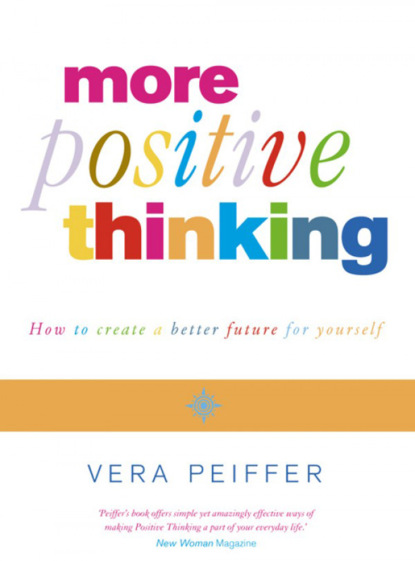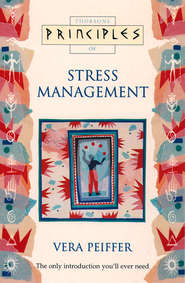По всем вопросам обращайтесь на: info@litportal.ru
(©) 2003-2025.
✖
Positive Thinking: Everything you have always known about positive thinking but were afraid to put into practice
Автор
Год написания книги
2018
Настройки чтения
Размер шрифта
Высота строк
Поля
To help you get over this initial difficulty, just use this trick. Pretend that you are playing a part. Pretend you are another person, a new person who is determined and confident, calm and collected. Choose a model and pretend that you are that person. Surely Superman never worries whether his glamorous outfit will materialise or whether he will be left in his underpants when he takes his whirl in the phone booth? Well, just make out you are Superman or Superwoman for that matter. Act confidently, even though your feelings may contradict you. Insist on being right about changing your thought patterns for the better. This first step is just for yourself: before you can convince other people of your new positive image, you have to convince yourself. Here’s how to go about it.
• Stand in front of the mirror and give yourself a winning smile.
• Tell yourself that, from today on, things are changing for the better.
• Tell yourself that you are making a fresh start. Whatever anybody said about you in the past is null and void. From now on you decide what you think about yourself and you choose to think well of yourself.
• Keep repeating your new motto, even if someone beats you to the last seat on the tube. You are not kidding yourself by doing so. You are simply making sure that you preserve your energy. You are about to achieve great things, and you will not allow yourself to be held back by trivialities.
5 Getting in Touch With Your Subconscious Mind (#ulink_5560ff11-b6e5-58db-b28a-928f57646856)
Your subconscious mind is not only concerned with storing memories and feelings, it is also the seat of creativity, intuition and ideas, all of which are intangibles.
Intuition appears suddenly, pointing you in a particular direction. An idea springs up in your mind while you are mowing the lawn and, within a second, you have the solution to a problem you have been thinking about for days. Your subconscious mind has helped you create a solution.
If you are an artist, your subconscious mind helps you in the same way: it provides you with an inspiration or creative idea for your next piece of work. Creative professions bring people more in touch with the subconscious than a lot of office jobs do. Creativity is mostly an undesirable item within the office environment as it tends to upset routine and sometimes is deemed to threaten the boss’s authority, particularly if it was someone in the lower ranks who had the good idea and not the boss!
Good ideas are not always acknowledged or put into practice, and quite a few of you will be able to confirm that for every good idea there are at least ten people who tell you that it can’t be done. Very often, routine is taking the place of flexibility, making your job and life in general much harder by setting unnecessary limits and making things boring.
Nowadays there exists a gross over-estimation of the achievements of the rational mind (which, as you will remember, only constitutes the minor part of our overall mental capacity) and an equally gross under-estimation of subconscious forces. We generally believe only what we can see and touch. We believe only things that are measurable and that are accompanied by tables filled with figures and experimental data. Creativity, intuition and ideas tend to rank fairly low (except for occasions where they have proved to make a lot of money) because they are not measurable and therefore officially do not exist. And yet, when we think about it, we see that everything that has ever been achieved started with an idea. Someone had a flash of intuition once and founded the company you are working for now. Someone had an idea once and started building the first car … and so on.
Note: Every achievement has started as an idea.
Think about it. What was it that made you buy this book? Maybe you saw the title or the cover and it gave you an idea of how to solve one of your problems? You probably went through the index to see whether there was a section on that problem, then began reading half a page into it and then bought the book.
Ideas can be sparked off by chance. They cannot be forced. Ideas have nothing to do with will-power. The harder you try to come up with an idea, the less you can do it. The more will-power you employ, the less likely is it that you will get to your subconscious. Ideas spring up as you are not looking, as you are thinking of something entirely different.
Equally, intuition has nothing to do with will-power. Intuition is a directive force within you that guides you in a seemingly irrational manner, and yet so often turns out to be right.
The subconscious mind is always working for you. Even when you have stopped thinking about a problem, your subconscious mind is still dealing with it, and when you are relaxed enough to listen to that inner voice, the subconscious will yield its solution in the shape of an intuition or an idea. This can occur either during the day or at night in a dream (albeit in a disguised form).
Dreams are a vehicle for discharging the anxieties and fears that you have accumulated during the day, thus enabling you to sleep. If it was not for your dreams, the anxieties would keep you awake and you would be unable to restore your energy by sleeping.
In order to make use of these subconscious facilities it is necessary to develop a sense for your ‘inner voice’. It is most important to keep your rational mind in check, otherwise it takes over and blocks the subconscious mind. Constant worrying and the general indulging in ‘disaster thoughts’ make you singularly unreceptive to any constructive ideas.
If you want to take advantage of intuition and creative ideas, you need to learn to partially switch off the conscious mind. Without knowing it, you sometimes do this quite naturally. Remember the times when you sit at your desk and gaze out of the window, not really looking at anything in particular, not taking in what is going on in your environment, and just thinking of something quite intently so that you can practically see it in front of you. At these times, you have switched into a day-dreaming mode where your reasoning mind is somewhat drowsy and permits you to wander off into whatever feelings or thoughts present themselves at the time. While you are day-dreaming, you are totally absorbed and you sit perfectly still. You can only do that when you don’t worry. As soon as you begin to worry you start fidgeting. Worrying is interference from your rational mind, and you need to keep it under control in order to benefit from your subconscious.
I would like you to try the following exercises so that you can:
• assess for yourself how easy or difficult you find it to relax
• become aware of the difference between being alert and being relaxed
• gain access to your subconscious mind.
Breathing Exercise
• Find yourself a comfortable position, either sitting or lying down.
• Uncross your legs and arms (crossing your legs and arms creates physical tension).
Note: Physical tension creates mental tension. Mental tension creates physical tension.
• Put one hand on your stomach area, just above the navel.
• Check the main tension points and consciously relax them:
• unclench your teeth
• drop your shoulders
• open your hands.
• Close your eyes and just be aware of the position of your body in the chair or on the bed. Concentrate on your head for a moment, then on your arms, the trunk of your body, your legs.
• Listen to your breathing for about ten breaths. Do not do anything. It is unimportant whether you breathe quickly or slowly, just listen to it.
• Now begin to take deeper breaths. As you breathe in, make sure you breathe in through your belly. If you are doing this properly, the hand on your stomach will rise with your expanding belly. As you exhale, your belly area will deflate and your hand sink down with it.
• Take ten deep breaths through your belly and for each one hold your breath for a count of five, then exhale again.
• Let your breathing go back to normal again.
• Gently tighten all your muscles and, as you release the tension, open your eyes again. You should feel physically calm now.
If you have problems
Are you finding it difficult to make your belly come out as you breathe in?
With your eyes open, try to make your belly round by pushing it out using your muscles. Leave your hand on your stomach so you know what it feels like. Now, combine pushing your muscles out with inhaling. Finally, try inhaling on its own again, making breathing the power that pushes out your belly.
Are you finding that you are not feeling relaxed at the end of the exercise?
Are you very worried about something? Any problems you have may well interfere with your exercise, making it more difficult to concentrate. This is normal. Do not resist these interfering thoughts, because resistance creates tension. Just say to yourself, ‘I can feel that I’m worried about something – this is OK. I will go back to worrying immediately after finishing this exercise. I resume my exercise now.’ Say this to yourself every time you find worrying thoughts interrupting your exercise.
Are you trying too hard to relax? Don’t try to be perfect. This exercise will definitely not solve all your problems; it merely helps to take the edge off any physical tension you may be under, so don’t expect to be comatose by the end of it! Doing this exercise is like taking a step back from everyday life, not more, not less.
Note: The harder you try to relax the less you can do it.
Are you angry at yourself for not relaxing better? Do you find it unbearable not to be the supreme champion at everything you are doing? Are you pushing yourself very hard at everything you attempt? If you have to answer yes to these questions, then it is high time you treated yourself better.
At the moment, you are over-critical and impatient, in other words, you are nasty to yourself. Don’t be! You deserve a break and you have the right to make mistakes and have faults, just like everyone else. Treat yourself like a little baby: with much love and gentleness. Now try the exercise again. You will see that you are doing better this time.
You can do this exercise anywhere, on the bus, on the tube, while you are waiting at the dentist’s, when you are exhausted and don’t have time for a nap, when you are stressed. Breathing properly will help take the edge off anxiety, recharge your batteries and enable you to think clearly.
Breathing deeply means that the entire lungs (rather than just the top halves) are filled with air and that, as a result, more oxygen gets into the blood. Oxygen is needed by the brain to function properly. Furthermore, deep breathing loosens and relaxes the belly muscles and the solar plexus, which is the area around your stomach where a great number of nerves come together. Relaxation of the solar plexus means that your inner organs can work properly. By breathing deeply, you are creating physical harmony.
Mental Holiday Exercise







